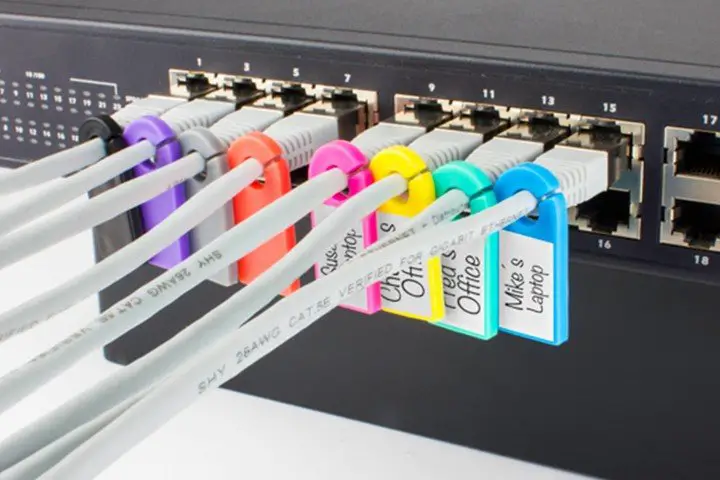This process allows you to significantly simplify electrical work, scheduled or emergency repairs, maintenance of facilities and cable lines during operation. Another functional purpose is to reduce the likelihood of emergencies and the resulting injury to workers.
The cable is marked already in the manufacturing process. The manufacturer must choose a color for the insulating sheath of the wire in accordance with international or domestic standards prescribed in the PUE, PTEEP, GOSTs and other documentation.
The data displayed on the outer sheath of the cable indicates information on several parameters:
- number of wires;
- cross-sectional area of the entire cable;
- applied insulating materials;
- wire materials, etc.
Such marking, although necessary, is not sufficient to improve safety during the operation of cable lines. Focusing on it, maintenance specialists will not be able to draw unambiguous conclusions about the purpose of the entire system or a specific section of electrical wiring.
Therefore, when performing electrical work, additional abbreviations are applied to the cable, adding information about the purpose of the circuit to the characteristics.
Thanks to this, tags with the following data appear on the insulation:
- cable brand;
- purpose;
- the object associated with it;
- line length and other information, if necessary.
Cable tags greatly simplify such marking, make it convenient and as fast as possible. They are selected depending on the diameter, characteristics and insulating materials on the wire.
They may differ in a number of parameters, but they have a common purpose and are able to store inscriptions for a long period of operation.
Labeling Requirements
Tags on the cable, fixed with clamps or threaded through the wire, must be signed in a certain way, this rule is regulated by the rules of the PUE. In accordance with this document, the following data is applied to the label:
Cable or line number. This is information that contains data about the direction of the highway, what it feeds, and what level of protection is required.
During the wiring installation, a passport of the object is drawn up, which indicates the buildings or premises that are powered by this line.
Numbers are assigned to them, which will subsequently be written on the tag itself, during the maintenance process, the master will be able to look at the cable tags and, by comparing them with the object’s passport, understand where this or that line leads;
Brand and wire size. Since the place on the tag is limited, the designation is written in abbreviated form, with a minimum number of characters. For example, a vinyl-coated cable with a cross section of 3 * 2.5 is briefly designated VVG-3 / 2.5;
Line voltage. A mandatory parameter, since it is not clear from the outer sheath of the cables what current flows through it, respectively, and what level of protection is required during repair work;
Beginning and end of cable lines. For more accurate information about possible losses on the line after its installation, the designation of the total length is applied. After reading the data, the master maintaining the line of wires will be able to accurately calculate the resistance and level of voltage loss in the network.
Inscriptions on Tags
All the above data are basic and mandatory. It is not forbidden to place additional information on the tag that characterizes the electrical main, for example, the date of laying.
In addition, when placing a tag on the coupling, it is imperative to place the date of installation of the wire, since the coupling has its own resource, which will be calculated based on this indicator.
On metal tags, inscriptions are most often made by engraving with a special pencil or indelible paint. Plastic products are signed with a permanent marker or indelible paint.
Also, when placing tags on the highway using wire, it is necessary to additionally protect metal objects with bituminous composition or any other paint, otherwise the wire will rust and collapse, and the tag will be lost.
Nylon thread is best suited for fasteners, it is not afraid of temperature changes and high humidity.
Wire Tag
Recently, to mark the cable on the line, many electricians began to use stickers that already have inscriptions informing about the voltage, as well as empty spaces into which additional data fits.
Such stickers are very convenient, since the master does not waste time on marking, but simply glues the element onto the finished tag and continues installation.
Types of Electrical Communications Device
The Electrical Installation Rules (PUE) in the “Electrical Wiring” section describe the methods for laying cables and wires. Section PUE 2.1 “Electrical Wiring” stipulates the rules for wiring power cables, lighting circuits and secondary DC and AC lines in rooms and along the facade of buildings and structures.
These are installation wires in a PVC sheath of all sections, unarmored power lines with a rubber or plastic coating in a sheath made of metal, rubber or plastic. Electrical wiring is of two types:
- open;
- hidden.
Open
Electric lines are laid on the surface of vertical and horizontal fences, supports and other building structures of buildings and structures.
The wires are attached directly to the supporting surface, suspended on cables, rollers and insulators. Communications are hidden in pipes, trays, boxes, in a metallized sheath, skirting boards, fillets, etc.
Hidden
The laying of conductors is carried out inside the enclosing structures of the premises: inside walls, ceilings, ceilings, they are placed in pipes, boxes or channels covered with plaster.
Important! Marking of cable and wire lines is carried out on open sections of the routes. It is necessary to designate hidden wiring subject to special conditions.
In accordance with the load on different sections of the power lines, the cross section of the conductors is selected, which will prevent the melting of the wires, otherwise it may cause a short circuit and ignition of the electrical wiring.







